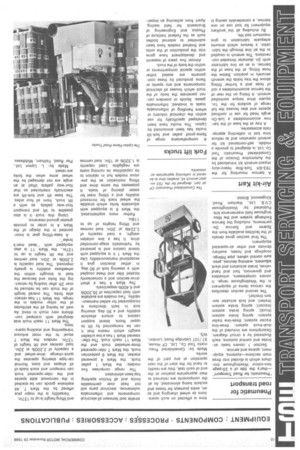Fork lift trucks
Page 72

If you've noticed an error in this article please click here to report it so we can fix it.
A comprehensive range of flame-proof pallet and fork-lift trucks has been announced by Upton. The trucks have been developed specifically for use within the chemical industry or where handling of inflammable loads is involved. Inflammable gases, liquids or powders cannot penetrate the body of the truck which houses all electrical components and any sparks or flame produced by these components are sealed either within special compartments or within the body of the truck.
Almost five years of research and development have gone into the production of the units and finished models have been submitted to external bodies such as the Federal Institute of Physics and Engineering of Brunswick for field testing. Apart from achieving an impen
etrable seal between all electrical components and inflammable substances, electrical parts will not heat over permissible limits and all friction sparking has been eliminated.
The range comprises five models: the Mark 1 pallet truck, the Mark 4 powered stacker, the Mark 6 pedestrian truck, the Mark 7 rider-operated three-wheeled truck and the Mark 11 reach truck. The tillersteered Mark 1 has a low unladen weight which means that it can be transported by lift to upper floors, lateral support castors to ensure absolute stability and a 90 deg. steering lock in both directions is incorporated for added manoeuvrability. Two models are available with load capacities of 35,200lb and 4,400lb respectively.
The Mark 4 has a short drive-section and a conveniently located tiller and these coupled with a steering lock of 90 deg. in either direction give it exceptional manoeuvrability. Like the Mark 1 it is equipped with lateral castors and is powered by hydrostatic stage-controlled drive. It has a low unladen weight, a load capacity of 2,224Ib at 20m. load centres and lifting heights of up to 118in.
Rather more sophisticated, the Mark 6 is equipped with adjustable forks which straddle the wheel track for increased stability and a tilting mast for easier placing of loads. It possesses the same drive and lifting motivation as the previous models but in relation to its capabilities its running costs are negligible. Load capacity is 1,320Ib at 15in. load centres and lifting height is up to 137in.
Versatility is the major plus offered by the Mark 7. All explosive goods can be stacked in the narrowest aisle spaces and the rider-operated truck can transport and stack loads of all shapes and sizes. Normal car-type steering operates the quick-change drive-wheel and a capacity of 2,200Ib at 20in. load centres and lift height of 137in. renders the Mark 7 equal to the most arduous transporting and stacking operations.
The Mark 11 reach truck was designed with cramped conditions very much in mind.' As well as having all the attributes of the other models in the range, the Mark 11 has retractable forks. The overall length of the truck can be reduced by over 2ft after loading by retracting the forks and because the load is brought Within the wheelbase stability is greatly improved. The load capacity is 2,200Ib at 20in. load centres and the lift height is up to 137in., the Mark 11 is also equipped with "dead man's brake".
A base-lifting gear is incorporated in the design of the Mark 4 in order to provide greater ground clearance. .
Using this truck it is also possible to lift and transport four-way pallets, as with a lift truck, from all four sides. The base lift and fork-lift are electrically interlocked so that four-way pallets lifted at an angle are not damaged by the wheel arms when the forks are raised.
Made by: L. Lipton Ltd., Pier Road, Feltham, Middlesex.




















































































































